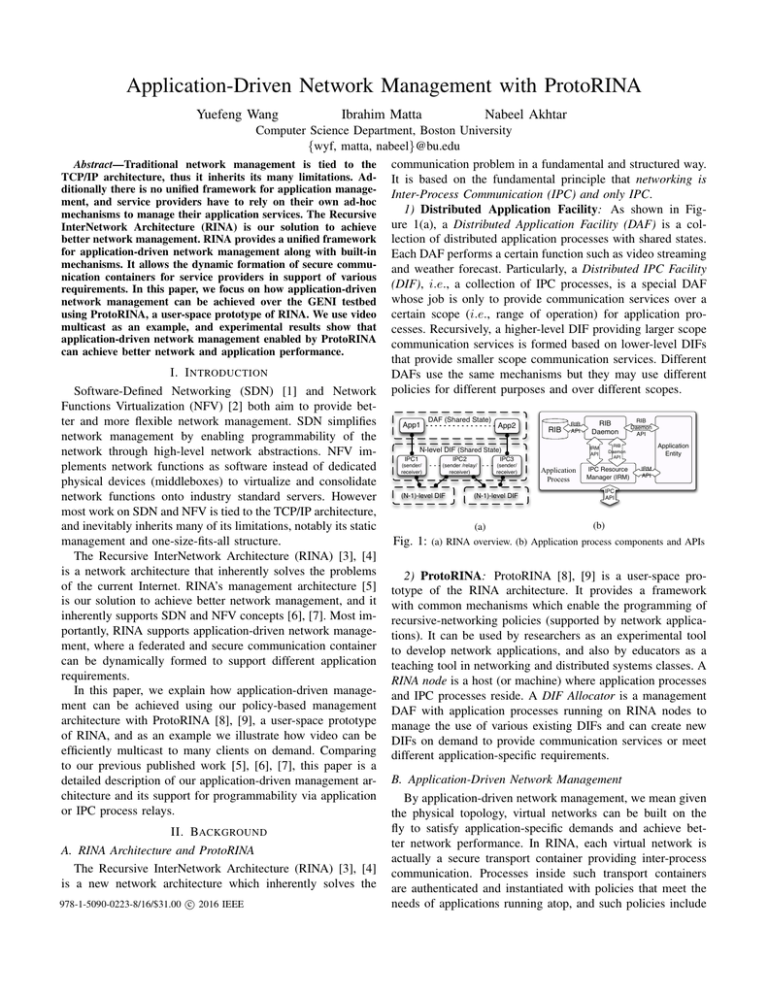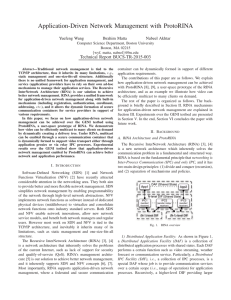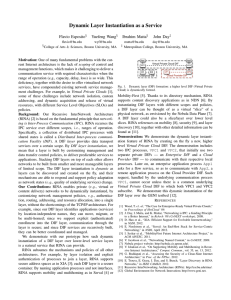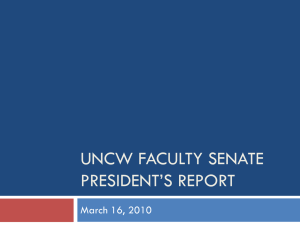Application-Driven Network Management with ProtoRINA Yuefeng Wang Ibrahim Matta Nabeel Akhtar
advertisement

Application-Driven Network Management with ProtoRINA
Yuefeng Wang
Ibrahim Matta
Nabeel Akhtar
Computer Science Department, Boston University
{wyf, matta, nabeel}@bu.edu
Abstract—Traditional network management is tied to the communication problem in a fundamental and structured way.
TCP/IP architecture, thus it inherits its many limitations. Ad- It is based on the fundamental principle that networking is
ditionally there is no unified framework for application manage- Inter-Process Communication (IPC) and only IPC.
ment, and service providers have to rely on their own ad-hoc
1) Distributed Application Facility: As shown in Figmechanisms to manage their application services. The Recursive
InterNetwork Architecture (RINA) is our solution to achieve ure 1(a), a Distributed Application Facility (DAF) is a colbetter network management. RINA provides a unified framework lection of distributed application processes with shared states.
for application-driven network management along with built-in Each DAF performs a certain function such as video streaming
mechanisms. It allows the dynamic formation of secure commu- and weather forecast. Particularly, a Distributed IPC Facility
nication containers for service providers in support of various
requirements. In this paper, we focus on how application-driven (DIF), i.e., a collection of IPC processes, is a special DAF
network management can be achieved over the GENI testbed whose job is only to provide communication services over a
using ProtoRINA, a user-space prototype of RINA. We use video certain scope (i.e., range of operation) for application promulticast as an example, and experimental results show that cesses. Recursively, a higher-level DIF providing larger scope
application-driven network management enabled by ProtoRINA communication services is formed based on lower-level DIFs
can achieve better network and application performance.
that provide smaller scope communication services. Different
I. I NTRODUCTION
DAFs use the same mechanisms but they may use different
Software-Defined Networking (SDN) [1] and Network policies for different purposes and over different scopes.
Functions Virtualization (NFV) [2] both aim to provide betDAF (Shared State)
RIB
ter and more flexible network management. SDN simplifies
RIB
RIB
App1
App2
Daemon
RIB API Daemon
API
network management by enabling programmability of the
Application
N-level DIF (Shared State)
network through high-level network abstractions. NFV imEntity
IPC1
IPC2
IPC3
(sender/
(sender /relay/
(sender/
plements network functions as software instead of dedicated
IRM
IPC
Resource
Application
receiver)
receiver)
receiver)
API
Manager (IRM)
Process
physical devices (middleboxes) to virtualize and consolidate
IPC
(N-1)-level DIF
(N-1)-level DIF
API
network functions onto industry standard servers. However
most work on SDN and NFV is tied to the TCP/IP architecture,
(b)
(a)
and inevitably inherits many of its limitations, notably its static
Fig. 1: (a) RINA overview. (b) Application process components and APIs
management and one-size-fits-all structure.
The Recursive InterNetwork Architecture (RINA) [3], [4]
is a network architecture that inherently solves the problems
2) ProtoRINA: ProtoRINA [8], [9] is a user-space proof the current Internet. RINA’s management architecture [5] totype of the RINA architecture. It provides a framework
is our solution to achieve better network management, and it with common mechanisms which enable the programming of
inherently supports SDN and NFV concepts [6], [7]. Most im- recursive-networking policies (supported by network applicaportantly, RINA supports application-driven network manage- tions). It can be used by researchers as an experimental tool
ment, where a federated and secure communication container to develop network applications, and also by educators as a
can be dynamically formed to support different application teaching tool in networking and distributed systems classes. A
requirements.
RINA node is a host (or machine) where application processes
In this paper, we explain how application-driven manage- and IPC processes reside. A DIF Allocator is a management
ment can be achieved using our policy-based management DAF with application processes running on RINA nodes to
architecture with ProtoRINA [8], [9], a user-space prototype manage the use of various existing DIFs and can create new
of RINA, and as an example we illustrate how video can be DIFs on demand to provide communication services or meet
efficiently multicast to many clients on demand. Comparing different application-specific requirements.
to our previous published work [5], [6], [7], this paper is a
detailed description of our application-driven management ar- B. Application-Driven Network Management
chitecture and its support for programmability via application
By application-driven network management, we mean given
or IPC process relays.
the physical topology, virtual networks can be built on the
fly to satisfy application-specific demands and achieve betII. BACKGROUND
ter network performance. In RINA, each virtual network is
A. RINA Architecture and ProtoRINA
actually a secure transport container providing inter-process
The Recursive InterNetwork Architecture (RINA) [3], [4] communication. Processes inside such transport containers
is a new network architecture which inherently solves the are authenticated and instantiated with policies that meet the
IRM
API
c 2016 IEEE
978-1-5090-0223-8/16/$31.00 RIB
Daemon
API
needs of applications running atop, and such policies include
private addressing, access control, routing, resource allocation,
error and flow control, etc. A DIF is such a secure transport
container. Each DIF has its own scope, and DIFs all use the
same RINA mechanisms but can have different policies.
Most recent work on network management, such as SDN
management platforms (e.g., [10], [11]) or NFV management
platforms (e.g., [12], [13]), focuses on managing the network
in a flat way where there is only one scope that includes
all elements (physical components, i.e., devices, and logical
components, i.e., processes) of the network. And they do
not allow dynamic instantiation of such transport containers
with different subscopes (subset of network elements) based
on application requirements. Some work has been done to
support network virtualization based on application requirements (e.g., [14] and [15]), but their virtual network is limited
to routing and not for transport purpose, and they do not
support the dynamic formation of virtual networks. With
the development of new service models (e.g., Software as a
Service), as well as the demand for different SLAs (ServiceLevel Agreements), we believe application-driven network
management is necessary and will become the norm.
(RIB) is the database that stores all information related to
the operations of an application process. The RIB Daemon
helps other components of the application process access
information stored in the local RIB or in a remote application’s
RIB. Each application process also has an IPC Resource
Manager (IRM), which manages the use of underlying IPC
processes belonging to low-level DIFs that provide communication services for this application process. The Application Entity is the container in which users can implement
different management (or application-specific) functionalities.
ProtoRINA (Section II-A2) provides two sets of APIs, RIB
Daemon API and IRM API, for users to write management (or
regular) applications and to support new network management
policies. The RIB Daemon API is based on a publish/subscribe
model and allows application processes to retrieve or publish
network information from/to other application processes. The
RIB Daemon also supports the traditional pulling mechanism
to retrieve information. The IRM API allows allocating/deallocating a connection (flow) to other application processes, and
sending/receiving messages over existing connections. More
details about RINA programming APIs can be found in [9].
III. RINA M ECHANISMS FOR A PPLICATION -D RIVEN
N ETWORK M ANAGEMENT
IV. V IDEO M ULTICAST W ITH P ROTO RINA
A. DAF-Based Management Architecture
A DAF is a collection of distributed application processes
cooperating to perform a certain function (Section II-A1).
RINA’s management architecture is DAF-based [5], i.e., application processes providing management functionalities form
different management DAFs, and the same DAF-based management structure repeats over different management scopes.
We would like to highlight two forms of management based
on scope. The first is DIF management, i.e., managing the DIF
itself to provide communication service within a small scope.
Examples of such management include different policies for
routing traffic or establishing transport flows among IPC
processes. The second is network management, i.e., managing
various DIFs that form the whole network. Examples of such
management include the dynamic formation of new DIFs to
provide communication services between remote application
processes. In the former case, the Management Application
Entity [9] of each IPC process inside the DIF forms the management DAF, and in the latter case, the DIF Allocator forms
the management DAF for the whole network (Section II-A2).
Our previous work [6] focused on the DIF management
where policies of a single DIF can be configured to satisfy
different requirements, while in this paper we focus on network management where new higher level DIFs can be formed
in support of application-specific demands. Our management
architecture is built on top on the RINA architecture, but it is
general, and can be used as a stand-alone management system
overlayed on top of any infrastructure, such as the Internet.
B. Application Process Components and RINA APIs
Figure 1(b) shows the common components of an application process in ProtoRINA. The Resource Information Base
Next we explain how video can be efficiently multicast
to different clients on demand as an example of applicationdriven network management. In order to support RTP (Realtime Transport Protocol) video streaming over the RINA
network, RTP proxies (server proxy and client proxy) are used
as shown in Figure 2. The RTP server proxy is connected
to the video server over the Internet, and each RTP client
proxy is connected to a video client also over the Internet.
The RTP server proxy and RTP client proxies are connected
over the RINA network which consists of DIFs. Namely,
the RTP server proxy redirects all RTP traffic between the
RTP server and RTP client to the communication channel
provided by the RINA network. In our experiments, we use
the VLC player [16] as the video client, and the Live555
MPEG Transport Stream Server [17] as the RTP video server.
The video file used in the experiments is an MPEG Transport
Stream file, which can be found at [18].
Internet connection
RTP Client Proxy
VLC Client
RINA Network
Live555
RTP Server
RTP Server Proxy
VLC Client
RTP Client Proxy
Fig. 2: Video clients (VLC players) are connected to the RTP video server
through RTP proxies over a RINA network
Figure 3 shows a scenario, where the whole network is made
up of four enterprise (or university) networks. The RTP server
and RTP server proxy are running in Network A, and they
provide a live video streaming service. There are two video
clients along with RTP client proxies (one in Network C
and the other one in Network D) that would like to receive
video provided by the RTP video server. Network A and
Network B are connected through DIF 1, Network B
and Network C are connected through DIF 2, and Network
B and Network D are connected through DIF 3. DIF 1,
DIF 2 and DIF 3 are three level-zero DIFs that can provide
communication services for two connected networks.
A very simple way to meet clients’ requirements is as follows. Two video clients can receive live streaming service from
the video server through two unicast connections supported
by two separate DIFs as shown in Figure 3. The unicast
connection between RTP Client Proxy 1 and the video
server proxy is supported by DIF 4, which is a level-one DIF
formed based on DIF 1 and DIF 2. The unicast connection
between RTP Client Proxy 2 and the video server proxy
is supported by DIF 5, which is a level-one DIF formed based
on DIF 1 and DIF 3. However, it is easy to see that the same
video traffic is delivered twice over DIF 1, which consumes
unnecessary network bandwidth. In order to make better use of
network resources, it is necessary to use multicast to stream
the live video traffic. Next we show two different solutions
of managing the existing DIFs to support multicast, i.e., two
ways of application-driven network management.
Actually the video multicast server provides a VNF (Virtual Network Function [2]) as in NFV (Network Function
Virtualization), i.e., RINA can implicitly support NFV. In a
complicated network topology with more local networks, if
there are more clients from different local networks needing
the live streaming service, we can instantiate more video
multicast servers, and place them at locations that are close
to the clients, thus provide better video quality and network
performance (such as less jitter and bandwidth consumption).
B. Solution Two: DIF-level Multicast
The second solution is supported using the multicast service
provided by the DIF mechanism. As shown in Figure 4b,
we form a level-one DIF DIF 4 on top of existing levelzero DIFs. The video server proxy creates a multicast channel
through DIF 4, and streams live video traffic over this
multicast channel. Each client joins the multicast channel to
receive the live video traffic. Note that the allocation of a
multicast connection is the same as the allocation of a unicast
connection, and both are done through the same RINA API.
RTP Client
Proxy 1
RTP Client
Proxy 1
Video
Multicast
Server
RTP Server
Proxy
RTP Client
Proxy 1
VLC Client 1
Live555
RTP Server
C
IP
Network
A
IPC 1
DIF 1
IPC 2
1
DI
F
IP
C
IPC 1
IPC 2
DI
Network
A
IPC 1
DIF 1
Network
B
IPC 2
DI
F
F
2
3
1
F
VLC
Client 2
Network
D
RTP Client
Proxy 2
(a)
DIF 4
IPC 1
Network
C
IPC 2
Network
A
DIF 1
DI
2
IF
Network
D
RTP Client
Proxy 2
2
Network
B
3
IP
C
Network
C
DIF 5
Network
C
2
RTP Client
Proxy 2
DI
DIF 4
C
IP
D
Network
B
IPC 3
RTP Server
Proxy
2
IPC 3
RTP Server
Proxy
IPC 4
F
3
Network
D
(b)
Fig. 4: (a) Video multicast through an RTP multicast video server. (b) Video
multicast through the multicast service provided by the DIF
IPC 3
Fig. 3: Video streaming through unicast connections, where same video traffic is delivered twice over DIF 1 consuming unnecessary network bandwidth
A. Solution One: Application-Level Multicast
The first solution is enabled through a video multicast video
server as shown in Figure 4a. The connection between the
video server and the video multicast server is supported by
DIF 1. The connection between the video multicast server
and RTP Client Proxy1 is supported by DIF 2, and
the connection between the video multicast server and RTP
Client Proxy 2 is supported by DIF 3. The video server
streams video traffic to the video multicast server, which
multicasts video traffic to each client through two unicast
connections supported by DIF 2 and DIF 3, respectively.
We can see that the video traffic is delivered only once over
DIF 1 compared to Figure 3. And we only rely on existing
level-zero DIFs, and no new higher-level DIF is created.
Here we can see that RINA implicitly supports SDN [1]
by allowing the dynamic formation of new DIFs (virtual networks). What’s more, it allows instantiating different policies
for different DIFs. In a complicated network topology with
more local networks, if there are more clients from different
local networks accessing the live streaming service, we can
either dynamically form new higher-level DIFs or expand the
existing DIFs providing the multicast service.
V. E XPERIMENTS OVER GENI
GENI [19] is a nationwide suite of infrastructure that
supports large-scale experiments, and it enables research and
education in networking and distributed systems. Through
GENI, users can obtain computing resources (e.g., virtual machines (VMs) and raw PCs) from different physical locations
(GENI aggregates), and connect these computing resources
with layer-2 (stitched VLAN) or layer-3 (GRE Tunnel) links.
In this section, we show our experimental results over GENI.
Chicago
Stanford
N2
N3
NYSERNET
Wisconsin
Chicago
N4
Rutgers
Wisconsin
N1
N2
GPO
N1
NYSERNet
N3
N4
N5
(b)
(a)
Fig. 5: (a) GENI resources from four GENI aggregates. (b) GENI resources
from five GENI aggregates
A. Bandwidth Usage
We reserve four VMs from four GENI aggregates (Rutgers,
Wisconsin, Chicago and NYSERNet) shown in Figure 5a, and
we connect the VMs using stitched VLANs. Each aggregate
corresponds to one network in Figure 3, where the RTP server
and RTP server proxy are running on VM N1 in the Rutgers
aggregate, the RTP Client Proxy 1 is running on VM
N4 in the Chicago aggregate, and the RTP Client Proxy
2 is running on VM N3 in the NYSERNet aggregate.
Figure 6 shows the bandwidth usage for the unicast solution
and the two multicast solutions (cf. Figure 3 and 4). We can see
that, as expected, the bandwidth usage for the two multicast
solutions are close to half of that of the unicast solution.
Bandwidth Usage (KB/sec)
900
800
Two Unicast Connections
DIF Multicast
App Multicast
700
VI. F UTURE W ORK AND C ONCLUSION
600
500
400
300
5
10
15
20
25
Time (sec)
30
35
The goal is to observe the effect on the video quality at
the video client side when placing the video multicast server
(cf. Figure 4a) in different locations, i.e., placing the video
multicast server either on VM N2 in the Chicago aggregate or
VM N4 in the NYSERNet aggregate. Since GENI does not yet
allow specifying parameters when reserving stitched VLANs,
such as capacity and latency, we use a network emulation
tool, NetEm [20] to add delay (1000ms ±500ms) on the link
between VM N1 in GPO and VM N2 in Chicago. To observe
video quality, we have VLC players running locally on our BU
campus network and connect them to the RTP client proxies
running on GENI aggregates (i.e., VM N3 and N5) via Internet
connections. Note that the jitter on the Internet connections is
negligible, and the jitter in our experiments is mainly from
jitter emulated on GENI links.
We run a VLC player locally and connect it with the
RTP Client Proxy 1 running on VM N3 in the Stanford
aggregate. Figure 7(b) shows the video observed when placing
the multicast server on VM N2 in the Chicago aggregate. Figure 7(a) shows the video observed when placing the multicast
server on VM N4 in the NYSERNet aggregate. We can see that
by placing the video multicast server at a location experiencing
less jitter we can achieve better video quality.
Regarding the time taken to establish/modify the multicast
tree, our recent measurements as shown in [21] indicate that
it is proportional to the size of the DIF and typically in the
order of a few seconds.
40
Fig. 6: Comparison of bandwidth usage over DIF1: unicast vs. multicast
B. Video Quality
We reserve five VMs from five GENI aggregates (GPO,
Chicago, NYSERNet, Stanford, and Wisconsin) shown in
Figure 5b, and we connect the VMs using stitched VLANs.
The RTP server and RTP server proxy are running on VM
N1 in the GPO aggregate, the RTP Client Proxy 1 is
running on VM N3 in the Stanford aggregate, and the RTP
Client Proxy 2 is running on VM N5 in the Wisconsin
aggregate.
In this paper, we described how to achieve applicationdriven network management using ProtoRINA. As an example,
we show how video can be efficiently multicast to many clients
on demand by dynamically creating a delivery tree. Under
RINA, multicast can be enabled through a secure communication container that is dynamically formed to support video
transport either through application proxies or via relay IPC
processes. We also highlighted RINA’s inherent support for
envisioned SDN and NFV scenarios. The experimental results
over the GENI testbed show that application-driven network
management enabled by ProtoRINA achieves better network
and application performance. As future work, we plan to
investigate how to build a RINA network and compose policies
given the physical topology to achieve better network and
application performance for different applications. Also we
plan to have our ProtoRINA run on a long-lived slice (virtual
network) over the GENI testbed to make a RINA network
available to researchers and educators so that they can opt-in
to offer or access new services.
R EFERENCES
(a)
(b)
Fig. 7: (a) Video observed when the path selected is with less jitter. (b)
Video observed when the path selected is with more jitter
[1] Open Networking Foundation White Paper, “Software-Defined Networking: The New Norm for Networks,” April, 2012.
[2] ETSI, “Network Functions Virtualisations (NFV) - White Paper,” https:
//portal.etsi.org/Portals/0/TBpages/NFV/Docs/NFV White Paper3.pdf.
[3] J. Day, I. Matta, and K. Mattar, “Networking is IPC: A Guiding Principle
to a Better Internet,” in Proceedings of ReArch’08 - Re-Architecting the
Internet (co-located with CoNEXT), New York, NY, USA, 2008.
[4] Boston University RINA Lab, http://csr.bu.edu/rina/.
[5] Y. Wang, F. Esposito, I. Matta, and J. Day, “RINA: An Architecture
for Policy-Based Dynamic Service Management,” in Technical Report
BUCS-TR-2013-014, Boston University, 2013.
[6] Y. Wang, N. Akhtar, and I. Matta, “Programming Routing Policies for
Video Traffic,” in CNERT 2014, Raleigh, NC, USA, October 2014.
[7] Y. Wang, I. Matta, and N. Akhtar, “Network Functions Virtualization
using ProtoRINA,” Poster at the 21st GENI Engineering Conference
(GEC21), Bloominton, IN, Oct 2014.
[8] Y. Wang, I. Matta, F. Esposito, and J. Day, “Introducing ProtoRINA:
A Prototype for Programming Recursive-Networking Policies,” ACM
SIGCOMM Computer Communication Review (CCR), July 2014.
[9] Y. Wang, F. Esposito, I. Matta, and J. Day, “Recursive InterNetworking
Architecture (RINA) Boston University Prototype Programming Manual,” in Technical Report BUCS-TR-2013-013, Boston University, 2013.
[10] T. Koponen, M. Casado, N. Gude, J. Stribling, L. Poutievski, M. Zhu,
R. Ramanathan, Y. Iwata, H. Inoue, T. Hama, and S. Shenker, “Onix:
A Distributed Control Platform for Large-scale Production Networks,”
in OSDI 2010, Berkeley, CA, USA.
[11] A. D. Ferguson, A. Guha, C. Liang, R. Fonseca, and S. Krishnamurthi,
“Participatory Networking: An API for Application Control of SDNs,”
SIGCOMM Comput. Commun. Rev., Aug. 2013.
[12] J. Martins, M. Ahmed, C. Raiciu, V. Olteanu, M. Honda, R. Bifulco,
and F. Huici, “ClickOS and the Art of Network Function Virtualization,”
in NSDI 2015, Seattle, WA.
[13] A. Gember-Jacobson, R. Viswanathan, C. Prakash, R. Grandl, J. Khalid,
S. Das, and A. Akella, “OpenNF: Enabling Innovation in Network
Function Control,” in SIGCOMM 2014, New York, NY, USA.
[14] R. Sherwood, G. Gibb, K.-K. Yap, G. Appenzeller, M. Casado, N. McKeown, and G. Parulkar, “FlowVisor: A Network Virtualization Layer,” in
Technical Report, OpenFlow-TR-2009-1, OpenFlow Consortium, 2009.
[15] E. Salvadori, R. Doriguzzi Corin, A. Broglio, and M. Gerola, “Generalizing Virtual Network Topologies in OpenFlow-Based Networks,” in
GLOBECOM 2011.
[16] VLC Media Player, http://www.videolan.org/.
[17] LIVE555 MPEG Transport Stream Server, http://www.live555.com/.
[18] http://csr.bu.edu/rina/RTPVideoSample/.
[19] GENI, http://www.geni.net/.
[20] NetEm. Linux Foundation, “http://www.linuxfoundation.org/collaborate/
workgroups/networking/netem.”
[21] Y. Wang and I. Matta, “A Recursive Approach to Network Management,” in Technical Report BUCS-TR-2015-014, Boston University,
2015.


